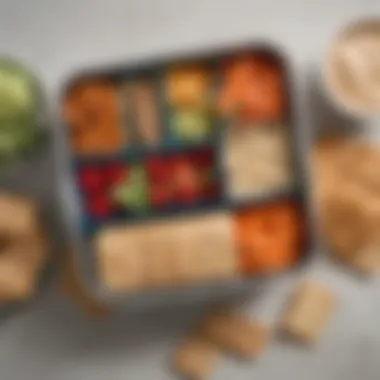Crafting Healthy Snacks for Busy Lifestyles


Intro
In today's fast-paced world, maintaining a healthy diet can feel overwhelming. Busy individuals often struggle to find the time and energy to prepare nutritious meals. This article explores the concept of healthy snacking as a practical solution to this common dilemma. We delve into how incorporating healthy snacks can support overall wellbeing and provide consistent energy throughout the day.
Understanding Healthy Snacking
Healthy snacks are more than just a means to satisfy hunger between meals. They play a crucial role in supporting a balanced diet, enhancing energy levels, and maintaining focus. By choosing nutritious options, one can effectively avoid processed, calorie-dense snacks that contribute to health issues over time.
"The right snack can provide essential nutrients, improve mood, and boosts productivity."
This guide not only highlights the benefits of snacking but also offers practical recipes tailored for busy routines. With a simple approach, you can enhance your diet without sacrificing time or taste.
Recipe Overview
- Snack Highlight: Savory Hummus and Veggie Cups
- Portions: Yields 8 servings
- Prep and Cook Time: 15 minutes total
- Difficulty Level: Easy
- Main Ingredients: Chickpeas, Tahini, Garlic, Olive Oil, Assorted Vegetables
Step-by-Step Instructions
- Prep Ingredients:
a. Rinse and drain one can of chickpeas.
b. Mince one clove of garlic.
c. Chop assorted vegetables (carrots, bell peppers, cucumber) into sticks. - Make Hummus:
a. In a food processor, add chickpeas, tahini, minced garlic, and a tablespoon of olive oil.
b. Blend until smooth, slowly adding water to reach desired consistency. c. Adjust seasoning with salt and lemon juice as preferred. d. Taste and blend further if needed. - Assemble:
a. Scoop hummus into party-size cups or bowls.
b. Arrange veggie sticks around the hummus for dipping.
Time-saving Strategies:
- Use store-bought hummus for added convenience.
- Pre-chopped vegetables can also save time.
Nutritional Information
- Calories per portion: Approximately 150
- Breakdown:
- Proteins: 5g
- Fats: 7g
- Carbohydrates: 18g
Beneficial Nutrients:
- Chickpeas provide fiber and protein.
- Vegetables are rich in vitamins and minerals, contributing to overall health.
Quick Cooking Tips
- Consider using an immersion blender for smooth hummus. This method saves dishes and time.
- Prepare larger batches of hummus for snacking throughout the week.
- Meal prep fresh veggie sticks in advance for grab-and-go options.
Related Recipes & Variations
- Tzatziki Sauce: A cooling dip that pairs perfectly twith fresh veggies.
- Guacamole: Rich in healthy fats, this dip is another great alternative.
- Feel free to adapt the hummus by adding ingredients like roasted red peppers or spices for variety.
Encourage fellow culinary enthusiasts to experiment with personal preferences, making their version of healthy snacks both delicious and nutritious.
Prelims to Healthy Snacking
In today's fast-paced world, the need for healthy snacking has become more evident. Busy individuals often find themselves caught in a whirlwind of responsibilities, leaving little time for proper meals. As a result, reaching for unhealthy, processed snacks is a common tendency. Understanding the importance of healthy snacking not only supports one's nutritional needs but also contributes greatly to overall well-being.
Understanding Nutritional Needs
To snack intelligently, one must first grasp what the body requires. Nutritional needs differ among individuals, depending on factors like age, gender, activity level, and health goals. However, general guidelines suggest that a balance of macronutrients—proteins, fats, and carbohydrates—is vital.
Incorporating a variety of elements in snacks can promote satiety and energy. For example, pairing proteins with carbohydrates provides sustained fuel, while healthy fats enhance flavor and help absorb fat-soluble vitamins. Additionally, snacks high in fiber can improve digestion and maintain a feeling of fullness longer. Knowing these basic principles enables individuals to make better selections, even in a bustling lifestyle.
The Role of Snacks in a Balanced Diet


Snacks should not be viewed merely as fillers between meals, but rather as essential components of a balanced diet. They can significantly influence daily nutrient intake. For instance, a mid-morning snack rich in nutrients can be especially beneficial, adding vitamins and minerals that might be lacking in regular meals.
Notably, snacks can boost mood and cognitive function by providing a steady stream of energy. Choosing nutrient-dense options can support brain health and aid performance throughout the day. Regularly consuming healthy snacks might help in maintaining blood sugar levels, reducing stress hormones, and stabilizing energy.
It is crucial for busy individuals to realize that snacking can align with their health outcomes. Every small choice adds up over time and influences long-term wellness.
"Healthy snacking is a fundamental, yet often overlooked part of our daily nutrition. Every bite counts."
Arming oneself with the knowledge of healthy snack options—not just the availability but also their preparation—is vital. An informed approach empowers busy individuals to prioritize health without compromising convenience.
Identifying Healthy Snack Choices
Identifying healthy snack choices is essential for those who lead busy lives. Snacking often fills the gaps between meals, providing energy and nutrition. However, making the right snack choices can happen is crucial for maintaining a balanced diet. A well-informed approach to snacking can vastly improve one's nutritional intake and energy levels throughout the day.
Healthy snacks, rich in flavor and good nutrients, do not necessarily require hours in the kitchen. Rather, it is about selecting the right foods and combinations to fuel productivity and well-being.
Recognizing Nutrient-Dense Options
Nutrient-dense snacks offer a high amount of vitamins and minerals relative to their calorie content. Choosing these options supports bodily functions efficiently. Examples of these nutrient-dense snacks include fruits, like berries and apples, which provide important vitamins as well as fiber. Vegetables, particularly raw ones, like carrots or bell peppers deliver similar benefits and can easily be combined with dips or spreads.
In addition to fruits and vegetables, options like plain yogurt or boiled eggs are also considered nutrient-dense. They contain protein and probiotics, contributing to digestive health and offering sustained energy, particularly during busy days. Those choosing these foods generally satisfy hunger for longer, reducing the temptation to reach for less nourishing options.
Consider looking for snacks that contain at least three grams of protein and two grams of fiber, which can help to keep you feeling full and energized. Whole foods generally make for translational nutrient-dense choices. The better snack options help fend off energy slumps, allowing for improved focus and motivation throughout the day.
Evaluating Snack Ingredients
Consideration of ingredients is essential in selecting snacks that fit health goals. Examining labels can reveal a great deal about what's packed inside a product. Ingredients should be recognizable and straightforward; this profile suggests a simpler, more healthful product. For example, snacking on raw almonds is a straightforward choice: the only ingredient present is the nut itself.
Conversely, processed snacks often boast long ingredient lists filled with sugar, unhealthy fats, and artificial preservatives. These concoctions can lead to cravings and energy crashes, far from effective nutrition boosts. Be wary of snacks claiming to be “healthy” that contain these processed elements.
Focusing on whole, unprocessed ingredients will generally result in healthier choices. A wise tip is to opt for items that contain a short and clear ingredient list. Labels often list ingredients from most abundant to least, which can offer insight into nutrition.
Remember: The shorter the ingredient list, usually the better. Opting for lower sugar and higher fiber contents also elevates the dietary benefits of any snack.
By applying these guidelines and healthy considerations, individuals can successfully identify nutrient-dense snacks, enriching their diets. Finding the right options simplifies the often overwhelming task of healthy eating in a fast-paced world.
Types of Healthy Snacks
Healthy snacks play an essential role in maintaining energy levels and providing nutrients throughout the day. Busy individuals often benefit from having accessible and nourishing snack choices that keep hunger at bay and prevent poor food choices. Selecting the right types of snacks can lead to better health and overall satisfaction.
Fruits and Vegetables
Seasonal Produce
Choosing seasonal produce offers numerous advantages. Seasonal fruits and vegetables are often fresher because they are harvested at their peak. This leads to enhanced flavor and greater nutrient density. For example, tomatoes in summer styles have robust flavor that cannot be rivalry by out-of-season produce. They are also likely to be more affordable, supporting local agriculture. Another characteristic that defines seasonal produce is its variety. Different seasons introduce new crops, thus diversifying an essential diet. The potential drawback is that they may require some planning to align with shopping habits, as seasonal availability varies.
Convenience of Pre-Cut Options
Pre-cut fruits and vegetables stand out for providing convenience to the busy individual. Ready-to-eat snack options substantially reduce prep time. It motivates snacking in general due to base of convenience. This option promotes better dietary choices by removing barriers to accessing healthy snacks. A downside, however, can be the environmental impact of packaging utilized for these products, potentially generating more waste. In some cases, the cost of pre-cut items may also be higher when compared to purchasing fruits and veggies whole. Finding the right balance between opportunity and resource can be vital.
Nuts and Seeds
Selecting Raw and Unsalted
Raw nuts and seeds come with numerous health benefits, including healthy fats, protein, and fiber. They support cardiovascular health when consumed in appropriate quantities. Their raw and unsalted characteristic helps to curb sodium intake, which is crucial for heart health. However, it is wise to consume them in moderation, as they are dense in calories. A practical suggestion is to store the raw nuts in opaque containers to maintain freshness and avoid of easy snacking.
Portion Control Strategies


Portion control of nuts and seeds plays a critical role in managing overall caloric intake. One method to enhance is by measuring servings ahead of time. Containers or small bags can be aligned with healthy servings, allowing snacks to be seen more clearly. Widely, idea promotes awareness of eat quantities. An effective plan for individuals seeking to maintain control is creating a snacking schedule, aligning consumption with dining habits throughout the day.
Whole Grains
Benefits of Whole Grain Snacks
Whole grain snacks offer several benefits, highlighting higher fiber content and essential nutrients which are often lost in refined grains. Consuming these snacks can lead to healthier digestion and improved heart health. They feel much more filling than their refined counterparts, potentially aiding in hunger management. Choosing whole grain options during a busy day bolsters energy levels and promotes sustained energy release. The major consideration is to verify that snacks are genuinely whole grain as some foods can easily be marketed misleading.
Snacks with Oats and Brown Rice
Oats and brown rice are prime examples of nutritious whole grains that can be incorporated into snacks. Oat-based snacks can offer protein and fiber, working together to provide immediate health benefits. Areas where these snacks shine include flavor versatility with elements in recipes and natural sweetness. Brown rice snacks add extra chewiness that is satisfying. However, nuts or added sweeteners within commercial products can add unexpected sugars or fats; families must read labels and ingredients to find the best certification.
Dairy and Dairy Alternatives
Low-Fat Choices
Low-fat dairy options can provide ample protein while managing caloric growth. Including these choices allows individuals to indulge without risks associated with full-fat counter-parts. Non or low-fat yogurts and milk can contribute valuable calcium and probiotics. Awareness of additives is integral because commercial low-fat products can sometimes compensate for taste with extra sugars. Understanding nutrition labels becomes especially relevant in making these diets a well-rounded success.
Plant-Based Options
Plant-based dairy alternatives are blossoming into mainstream popularity. Almond milk, coconut yogurt, and oat milk have drawn significant attention due to taste and lower environmental impact. These options often cater to those with lactose intolerance or seeking vegan diets. Furthermore, they can be enriched with vitamins and minerals to assist specific dietary needs. A small challenge faced STEMs from their varying texture and missed flavor profiles compared to traditional dairy which can alter preferred recipes.
Easy Healthy Snack Recipes
Incorporating easy and healthy snack recipes into your daily life is vital for busy individuals. Nutritious snacks can serve to bridge the gap between meals, providing a quick source of energy and essential nutrients. These recipes not only prioritize health but also offer a delightful experience in the kitchen, even for those with limited time. Below, discover a selection of recipes that are simple, quick, and ingredient-friendly, making them perfect for your scattered schedule.
Quick Fruit and Nut Mix
A Quick Fruit and Nut Mix serves as an excellent antidote to mid-day energy slumps. This snack is fully customizable based on your taste and nutritional preference. Combine dried fruits like apricots, raisins, and apples with varied nuts such as almonds, cashews, or walnuts.
Here are some benefits:
- Nutrient-Dense: This mix is rich in fiber, healthy fats, and protein to keep you full.
- Portable: It easily fits into a small container, making it perfect for on-the-go snacking.
- Adaptable: Adjust your selection to align with available seasonal ingredients.
Vegetable Sticks with Hummus
Vegetable Sticks with Hummus is a classic healthy staple. This combination packs crunchiness and creaminess into one simple snack. To prepare, chop vegetables like carrots, celery, and bell peppers into sticks.
Serve them alongside hummus, which offers
- Vitamins: Vegetables contribute important vitamins like A and C.
- Balanced Nutrition: Hummus provides protein and fiber from chickpeas, supporting satiety and energy.
You can easily prepare homemade hummus with ingredient like tahini and garlic to enhance the flavor further.
Yogurt Parfait with Berries
Creating a Yogurt Parfait with Berries offers a relax nature within snack time. Choose low-fat yogurt as your base and layer it with fresh berries such as blueberries, strawberries, or raspberries.
Here are the benefits:
- Probiotics: Yogurt contains beneficial bacteria helping gut health.
- Antioxidants: Berries are well-known for boosting immune system with their antioxidants.
- Satiating: This parfait is a nice combination of protein, carbs, and healthy fats.
You can top it with granola for added texture or a sprinkle of chia seeds for an extra nutritional boost.
Whole Grain Crackers with Cheese
Whole Grain Crackers with Cheese becomes a filling and satisfying snack. Look for whole grain crackers that are high in fiber and pair them with a range of cheeses.
Consider the numerous advantages:
- Whole Grains: They help with digestion due to dietary fiber content.
- Protein and Calcium: Cheese delivers essential protein and calcium.
For variety, you may choose low-fat cheeses or even tasty plant-based alternatives for those with dietary restrictions. This creates a fulfilling experience by offering textures and taste balance.


Opting for these easy recipes ensures that delicious, healthy snacks are not just a dream but a reality in a busy lifestyle. Stick to your nutrition goals while managing a hectic schedule, focusing on convenience, taste, and health.
Tips for Preparing Healthy Snacks
Preparing healthy snacks is a fundamental aspect of maintaining a nutritious diet, especially for those with busy lifestyles. As schedules become more demanding, convenience often overrides health considerations. This section emphasizes the importance of putting thought into snack preparation, ensuring not only that these bites nourish the body but also fit seamlessly into the fast pace of everyday life.
The benefits of applying effective snack preparation tactics include enhanced nutritional intake, reduced impulse snacking on unhealthy options, and a sense of control over one's diet. With better planning, individuals can quickly access snacks that enhance their energy levels and overall health a significant factor for busy individuals.
Batch Preparation Techniques
Batch preparation refers to the process of preparing larger quantities of snacks at once, intending to have quick options on hand. This approach saves time while reducing the chances of skipping healthy foods.
One useful technique is to dedicate a few hours once a week for this task. Consider options like making roasted chickpeas, granola bars, or veggie sticks. Once prepared, these items can be portioned into containers or bags, stored in the fridge or pantry, ensuring they’re readily accessible. Here are some specifics to remember:
- Choose versatile ingredients: Ingredients like nuts, seeds, oats, and dried fruits can combine for various snacks.
- Cook and build: Bake a batch of healthy muffins or energy balls; these can serve as snacks or even breakfast.
- Labeling: Clearly label containers with preparation dates to maintain freshness awareness.
Utilizing Leftovers Creatively
Using leftovers can transform what might end up as waste into nutritious snacks. This approach not only minimizes food waste but also provides endless culinary possibilities. With a bit of creativity, ordinary leftovers can become the main act rather than a supporting side.
For example:
- Wraps: Utilize leftover grilled chicken, veggies, and hummus in wraps for a quick bite.
- Salads: Toss leftover grains with some greens and a protein source can create a satisfying snack.
- Soups: Be creative with smoothie bowls by blending leftovers with fresh fruits for added flavor and nutrition.
Storing Healthy Snacks
Storing healthy snacks correctly is crucial for busy individuals. Proper storage ensures that snacks remain fresh, nutritious, and readily accessible. Understanding how to store different types of snacks can be a basic yet vital step in integrating healthy choices into one's lifestyle.
Best Practices for Shelf Life
Maintaining the shelf life of healthy snacks is essential. Here are some best practices to follow:
- Use Appropriate Containers: Glass or BPA-free plastic containers are ideal. They prevent moisture and air from entering, which can lead to spoilage.
- Seal Snacks Effectively: Consider vacuum sealing when possible. This method removes air, minimizing oxidation, which can spoil quality over time.
- Label and Date: Always label with the contents and date of preparation. This helps in tracking freshness and reduces any confusion when choosing snacks.
Expiration dates can vary between snacks. Always check before consuming them.
Portion Control and Containers
Effective portion control can aid in maintaining a balanced diet and assist in managing caloric intake. Here are steps you can take:
- Pre-Packaged Batches: Divide snacks into small portions in separate containers. This simplifies your snacking choice without overindulging.
- Use Visual Cues: Choose containers that emphasize portion control. Smaller containers can facilitate mindful eating.
- Portable Options: Consider using reusable, portable containers for on-the-go snacking. I’ve even found small snack bags helpful for items like nuts or mixed snacks.
Advantages of Proper Storage
- Enhances flavor and retains nutrients
- Reduces waste due to spoilage
- Facilitates ease of choosing healthy snacks during busy hours
The End: Making Healthier Choices
As we explore the realm of healthy snacking, it becomes vital to recognize that making informed choices bears substantial consequences for our well-being. The journey underscores the significance of incorporating nutritious snacks into our routines. Healthy snacks not only fill the void between meals but also serve as practical vehicles for essential nutrients. Research affirms that strategic snacking can lead to better overall health, improved energy levels, and a balanced diet.
Sustaining Healthy Habits
Establishing sustainable habits is crucial for anyone aiming to make long-term dietary changes. Priority begins with consistency. It's important to create a routine where healthy snacks form an integral part of meals. After all, integrating fruits, vegetables, whole grains, and nuts should feel habitual rather than enforced. To achieve this, consider putting in place the following strategies:
- Plan Your Snacks: Designate specific times for snack breaks. This enables a proactive approach to snacking, reducing the likelihood of impulse decisions that may lead to unhealthy choices.
- Create Positive Associations: Enjoy snacks during relaxing moments, such as while reading or spending time with family. By creating pleasant contexts, one can foster lasting habits.
- Progressive Approach: Gradually replace less healthy snacks with better options. Over time, small adjustments culminate in significant changes, making the diet healthier without overwhelm.
Encouraging Family Participation
Healthy snacking can transform from an individual endeavor into a collective lifestyle. Engaging family members is essential not only for broader acceptance of nutritious options but also for enriching family bonds. Consider involving your loved ones in the following ways:
- Involve Everyone in Planning: Involve your family in deciding which snacks to prepare or purchase. Discussing choices strengthens everyone’s commitment to healthier eating.
- Snack Preparation Together: Prepare snacks as a family project. Making yogurt parfaits or assembling vegetable sticks allow for creativity while also guarding against unhealthy habits.
- Family Challenges: Initiate friendly competitions around healthy snacking. For example, set a challenge to find the newest or most creative snack idea each week, providing an exciting incentive to try nutritious variants.
By creating avenues where healthy choices become commonplace, the intention remains clear: nourishing our bodies positively shapes how we feel and interact daily.







